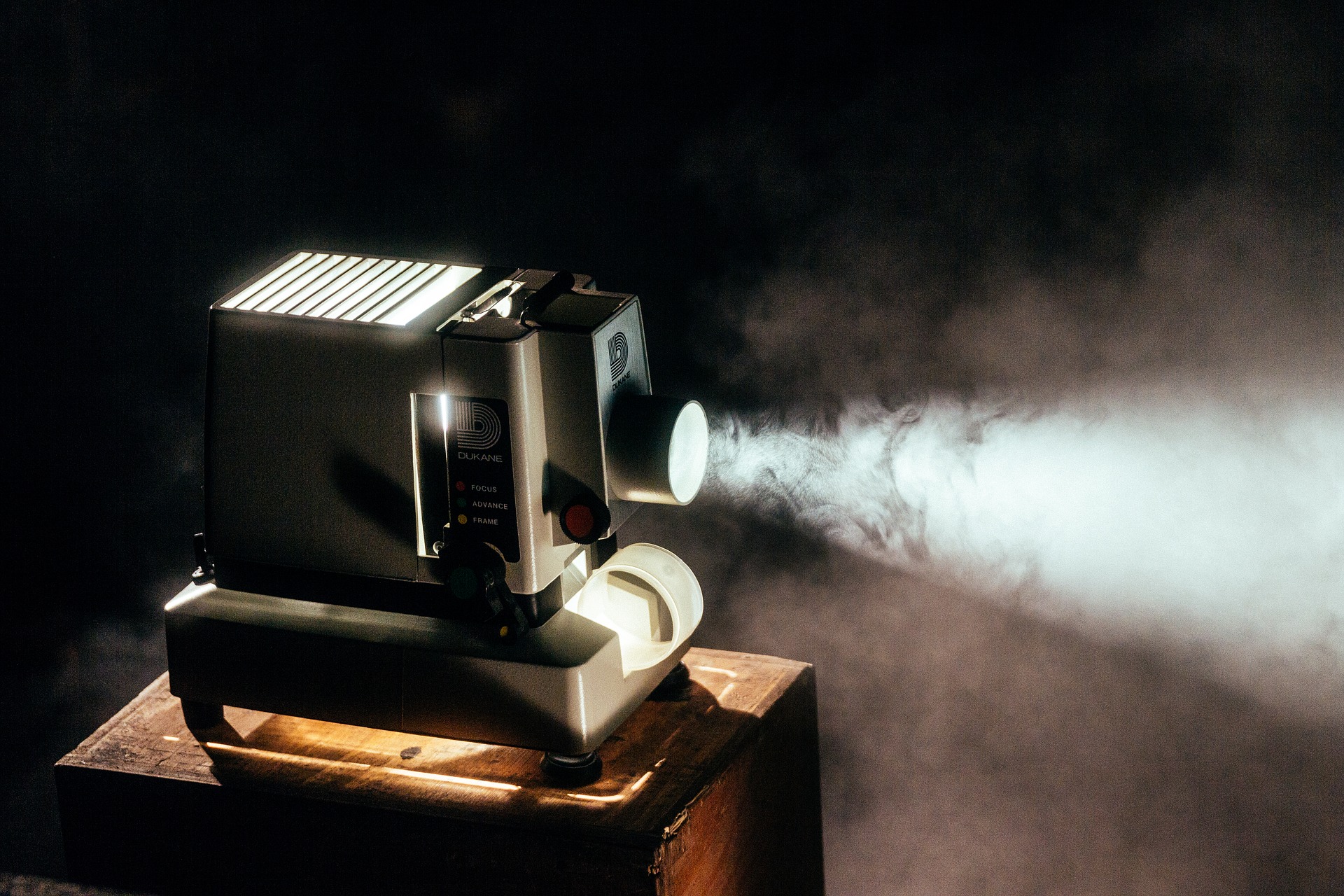| Sneak Peak @ our Top Picks for the Best Home Theatre Projector | |||
| Rank | Product | Price | Rating |
| #1 |
 |
$$$ |
A+
|
| #2 |
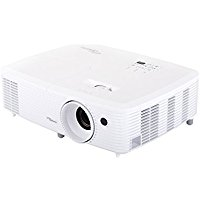 |
$$$$ |
A+
|
| #3 |
 |
$$$ |
A
|
Contents
Projectors were once toys that were exclusively for the rich and famous. They were expensive to buy, they were even more expensive to maintain, and they required very dark (and often dedicated) rooms to be used in. As such, for the everyday big screen enthusiast, the only way to get the immersion of a projector sized screen was to go to the cinema.
These days things are very different. There has been an explosion in projector popularity in recent years thanks to production costs free falling, and maintenance becoming highly affordable.
In 2019 there is a wide range of different of projectors on the market, but which one should you choose? And what makes one projector better than another?
Well, today we are going to find out as we take an in-depth look into the world of projectors in our 2019 buyers guide. We’re going to end this article with a review of 8 projectors that we highly recommend you add to your shortlist.
Let’s get started.
What To Look For When Buying A Home Theatre Projector
To understand our recommendations you’re going to need to learn about the most important features and specifications that you’re likely to encounter when shopping around. As you can imagine, these specifications can get quite detailed and very geeky, so we’re only going to discuss the most important ones below.
DLP vs LCD
All projectors currently on the market can be categorized into two different types – digital light processing (DLP), and liquid crystal display (LCD). The technical differences between these two projection methods are detailed enough to be the subject of their own article. So for the sake of brevity, we’re just going to tell you how they are different from one another.
Advantages Of DLP – DLP projectors are usually much more lightweight than LCD projectors, which makes them perfect for smaller portable “pico” projectors that are commonly used with smartphones. They recreate a cinema-style experience with very smooth motion and low amounts of ghosting.
One of the main advantages DLP projectors have over LCD models is that the blacks they are able to create are much darker and truer. This has a dramatic effect on the overall viewing experience and provides a greater sense of depth to the images.
Note: Obviously you can’t project the color black. DLP projectors are simply better at creating darker and more accurate “shadows” on the screen compared to LCD products.
DLP projectors also usually have higher contrast ratios than LCD projectors which adds more detail to the darker areas of the picture. Some of the more recent (and expensive) DLP projectors are now using “3 chip DLP”. Again this is very technical, but just know that it provides a much better picture, and if possible you should get a model that has 3 chip technology.
Advantages of LCD – Liquid crystal display projectors (LCD) are probably the most common kind of projector on the market. They are slightly bigger and heavier than DLP products, but they also have several notable advantages. For example, LCD projectors are almost always brighter than DLP products of a similar price. This means that they provide a much more vivid picture, especially when you don’t have complete darkness in the room.
LCD projectors generally provide a much sharper image than DLP products too and many people consider their picture quality to be superior to DLP projectors. However, with the advent of 3 chip DLP, this difference is becoming smaller and smaller as time goes on. As an added bonus they are also usually much quieter and are more energy efficient than DLP products too.
Light Sources
As you can imagine, the light source of a projector is very important as it’s what will mainly determine the brightness, reliability, and picture quality of your final image. There are three main light sources to choose from – lamp, laser, and LED.
Lamp – Lamp projectors (sometimes called standard lamps) are the oldest and most affordable option. They were once the only option available domestically and they did a perfectly fine job, but these days they live in the shadow of laser and LED products. That being said, lamp projectors are bright and they can provide you with a more than acceptable picture quality.
The main issue with lamp projectors is that the bulbs inevitably break over time. They can last anywhere between 3,000 and 5,000 hours before needing to be replaced (depending on the brand). You should be aware that replacement projector bulbs are much more expensive than a household bulb, and replacing them can be costly.
LED – Like lamp projectors, LED projectors also use a bulb to produce light. However, the bulbs are very different and a LED bulb will last at least 20,000 hours on average – which is an exceptional amount of viewing time. Many people never replace a bulb in a LED projector unless they are using it for prolonged periods of viewing on a daily basis.
They have better color control than lamp projectors and use far less energy too. This energy efficiency means that LED projectors run much cooler than lamp projectors and don’t need a huge noisy fan to be run during operation (which can otherwise be quite distracting).
Laser – Laser projectors are one of the newest versions of projector to hit the market, and many people swear by them as the only way to go. The main benefit laser projectors have over LED and lamp projectors is that they don’t use a bulb (which means you never need to replace anything).
They are also the brightest kind of projector by a very long way. Even some of the most powerful LED and lamp products on the market will struggle to keep up with the brightness of a “basic” laser projector. They provide exceptional contrast, have a much wide color range than lamp projectors, and they are incredibly energy efficient too.
But all this functionality comes at a cost, and they’re not exactly cheap.
Brightness
You’ll see projector manufacturers making a very big deal about how bright their products are. Ever since projectors were first being marketed to domestic users there has been an arms race to provide the brightest picture at the most affordable price point.
Projector brightness is measured in lumens, the more lumens it has – the brighter it is. Every projector will have two different brightness specifications, white brightness, and color brightness.
White brightness relates to the amount of white light that is output by the projector, and color brightness relates to how much yellow, red, and blue light is output. Ideally, you want to find a projector that has color brightness that is equal to (or greater than) its white brightness. If the white brightness is significantly higher than the color brightness then images can start to feel a little faded and washed out.
If you’ve got a dedicated projector viewing room that can provide you with complete darkness then having a super bright projector can actually be a bad thing. It can strain the eyes after a while and you may lose some of the detail in the dark areas. However, if you don’t have a dedicated home cinema room – brighter is usually better.
Coxtrast Ratio
The contrast ratio of a projector tells you the maximum difference in brightness between the darkest areas of the screen and the brightest areas. The higher the contrast ratio, the better and more detailed the darker parts of your screen will be. This is an important metric, and low contrast ratios can make some very dark scenes almost un-viewable.
Resolution
Projector resolution works similarly to the resolution of your TV or your computer. The more pixels it has, the crisper and clearer the image will be. As such, you should always get a projector with the highest resolution you can afford. If you’re going to mainly be watching movies you should at least aim for a 1080p product to give you a true cinema-like experience.
Overall Best Home Theater Projector for 2019
Optoma HD142X
 We’re going to list a few different projectors below that are winners of their respective classes, but this product from Optoma is hands down the best overall home theatre projector on the market in 2019. It provides exceptional true 1080p picture quality at an affordable price point.
We’re going to list a few different projectors below that are winners of their respective classes, but this product from Optoma is hands down the best overall home theatre projector on the market in 2019. It provides exceptional true 1080p picture quality at an affordable price point.
It provides incredible brightness with its 3,000-lumen rating and its got a super sharp 23,000:1 contrast ratio that will provide detail in even the darkest sections of the screen. It’s capable of displaying 3D images perfectly from almost any source, and its 144Hz refresh rate ensures you see some of the smoothest images on the market.
It’s a lamp projector, which does mean you’re going to have to replace the bulb once in a while. However, Optoma has engineered their bulbs to last much longer than average and you’ll get at least 8,000 hours of use out of it before noticing any degradation. The screen size is around 66 inches when placed 8 feet away, and 107 inches from 12 feet away. It’s got all the usual HDMI connections and other standard AV ports, and it even includes a little 10-watt speaker (which we don’t recommend you use).
Honestly, for the price, there is nothing on the market that even comes close to this kind of capability. Sure you can get a better product if you’ve got thousands to spend. But if you’re looking for a great product at a reasonable mid-range price point – then this should be at the very top of your shortlist.
| Best in Class Home Threatre Projectors in 2019 | |||
| Rank | Product | Price | Rating |
| Overall |
 |
$$$ |
A+
|
| Budget |
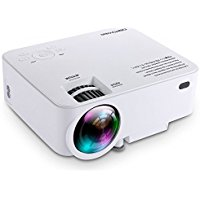 |
$ |
B-
|
| Under $1000 |
 |
$$$$ |
A+
|
| Under $500 |
 |
$$$ |
A
|
| Under $200 |
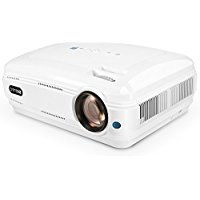 |
$$ |
B+
|
| Under $100 |
 |
$ |
B
|
| Gaming |
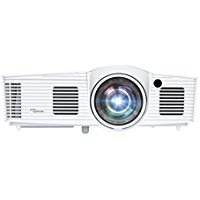 |
$$$ |
A+
|
| Movie |
 |
$$ |
A+
|
Best in Class Projectors
Let’s take a look at some other very respectable projectors that are more than worthy of your consideration.
Budget: DBPOWER T20
 This is one of the cheapest products we’re going to recommend today, and it’s going to seem a little underpowered to the Optoma above. But as it’s around $500 cheaper you should set your expectations accordingly. That being said, it’s astonishing that DBPOWER has managed to create a true 1080p projector that they can sell for less than $100.
This is one of the cheapest products we’re going to recommend today, and it’s going to seem a little underpowered to the Optoma above. But as it’s around $500 cheaper you should set your expectations accordingly. That being said, it’s astonishing that DBPOWER has managed to create a true 1080p projector that they can sell for less than $100.
It’s a portable LCD projector that can provide a decent 1,500 lumens of brightness from its lamp-based system. The lamps will last you a respectable 5,000 hours before needing to be replaced and the projector produces what we consider to be a decent picture quality. The contrast ratio is probably the only thing that’s a little bit lacking here coming in at 1000:1. This means that dark areas of the picture may lose some of their detail, especially in rooms that don’t have perfect darkness.
However, it’s a more than acceptable product, and for less than $100, it’s a bargain.
Best Under 1000: Optoma HD29Darbee
 This is the second Optoma product on our list, and it’s actually a better product than the one we chose as our overall top pick (but it’s also more expensive). Its got a super bright 3,300-lumen rating and its got an incredible 30,000:1 contrast ratio. It’s going to provide bright, clear, and sharp images that have an amazing level of depth to them – even in dark areas.
This is the second Optoma product on our list, and it’s actually a better product than the one we chose as our overall top pick (but it’s also more expensive). Its got a super bright 3,300-lumen rating and its got an incredible 30,000:1 contrast ratio. It’s going to provide bright, clear, and sharp images that have an amazing level of depth to them – even in dark areas.
It’s a DLP projector that uses a lamp as a light source. Just like our top pick these lamps are exceptionally durable and will last around 8,000 hours on average. It’s 3D capable and provides a gloriously detailed 1080p full HD image that can be viewed closely without pixilation. It’s the best product on this list, but at over $700, it’s not exactly cheap.
Best Under 500: EUG 3500 Lumens
 This is one of the brightest projectors on our list, and it’s great value for money – providing you don’t mind dealing with an unknown brand. It’s an LCD LED projector that displays a great 1080p true HD image worthy of anyone’s consideration.
This is one of the brightest projectors on our list, and it’s great value for money – providing you don’t mind dealing with an unknown brand. It’s an LCD LED projector that displays a great 1080p true HD image worthy of anyone’s consideration.
The one thing that lets this projector down slightly is the contrast ratio of 4500:1. It’s not the end of the world, and the picture it produces is more than acceptable by anyone’s standards. But you may notice that some darker details are a little less visible than they should be.
Best Under 200: Crenova XPE680
 We’re entering the budget zone with this product, and again you should set your expectations accordingly. It’s a reasonably bright product that can produce 2,800 lumens from its LED bulb (which will last at least 20,000 hours before needing to be replaced). However, you’re going to need to be in quite a dark room while watching to ensure you receive the full picture quality.
We’re entering the budget zone with this product, and again you should set your expectations accordingly. It’s a reasonably bright product that can produce 2,800 lumens from its LED bulb (which will last at least 20,000 hours before needing to be replaced). However, you’re going to need to be in quite a dark room while watching to ensure you receive the full picture quality.
The contrast ratio of 2,000:1 isn’t the best in the world, but considering the price – it’s more than worthy of being added to your shortlist if you’re on a budget. It provides a 1080p full HD image that (providing you’ve got a dark enough room) will provide a great viewing experience.
Best Under 100: DR.J Mini Projector
 This small and portable product is a great option for those on a budget. It’s not got the power and specifications of some of the better products we have discussed today – but it gets the job done.
This small and portable product is a great option for those on a budget. It’s not got the power and specifications of some of the better products we have discussed today – but it gets the job done.
It’s an LCD LED projector with a super durable bulb that will last up to 40,000 hours before needing to be replaced. It manages to produce a full 1080p HD image and has a low (but adequate) 1,800-lumen rating. Again this means you’re going to need to be in a dark room for best results – but if you have that, then it’s a great product.
Best Gaming: Optoma GT1080Darbee
 Gaming projectors are all about having the lowest amount of latency possible. You need lightning fast reactions, and even the slightest delay can cause your gaming experience to suffer. The almost instant 16ms latency rating on the GT1080Darbee is about as quick as projectors get, and it’s our ultimate gaming pick.
Gaming projectors are all about having the lowest amount of latency possible. You need lightning fast reactions, and even the slightest delay can cause your gaming experience to suffer. The almost instant 16ms latency rating on the GT1080Darbee is about as quick as projectors get, and it’s our ultimate gaming pick.
With its 3,000 lumens you’ll be able to play without complete darkness, and its amazing 28,000:1 contrast ratio means you’ll be able to see people hiding in even the darkest corners of your game. It’s a 1080p product that is 3D ready and its super short throw ensures that you can create a big screen in a limited space.
Best Movie: Optoma HD142X
 We were going to recommend another product as our best movie pick, but in all honesty the Optoma HD142X we chose as our overall best pick is also the best for movies too. If you’ve made it this far down the article we assume you’ve already come to the same conclusion about it that we did.
We were going to recommend another product as our best movie pick, but in all honesty the Optoma HD142X we chose as our overall best pick is also the best for movies too. If you’ve made it this far down the article we assume you’ve already come to the same conclusion about it that we did.
It’s hands down the best value projector in 2019, and unless you’re on a tight budget (or want a dedicated gaming projector), we see no reason why you’d choose anything else.
Conclusion
So there you have it, the best home theatre projectors on the market in 2019. We’ve listed quite a few different excellent options here today, all of which are more than worthy of your consideration.
As a parting note, we’d like to point out that you often get what you pay for with projectors. The $100 products are nowhere near as good as the $500 – $700 products, it’s not a small difference – they are entirely different classes of product.
If you can afford one of the more expensive products we’ve discussed today – we highly recommend you consider them.

